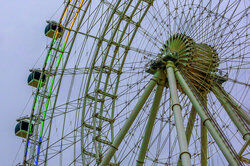The unbalanced masses of a locomotive may be divided into two parts, namely, masses which revolve, as the crank-pins, the crank-cheeks, the couplingrods, &c.; and masses which reciprocate, made up of the piston, piston-rod, cross-head and a certain proportion of the connecting-rod.
Small objects are often heaped together in perforated trays or ladles, the cathode connecting-rod being buried in the midst of them.
By adjusting the length of the connecting rod and the amount of water in the vessel, the amount of steam admitted can be regulated to a nicety.
In balancing the mechanism of a steam engine it is often sufficiently accurate to consider the motion of the pistons as simple harmonic, and the effect on the framework of the acceleration of the connecting rod may be approximately allowed for by distributing the weight of the rod between the crank pin and the piston inversely as the centre of gravity of the rod divides the distance between the centre of the cross head pin and the centre of the crank pin.
Dalby, On the Balancing of the Reciprocating Parts of Engines, including the Effect of the Connecting Rod (ibid., 1901).





